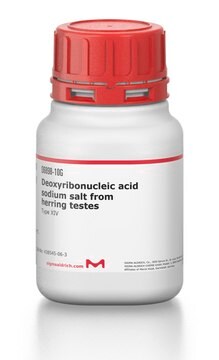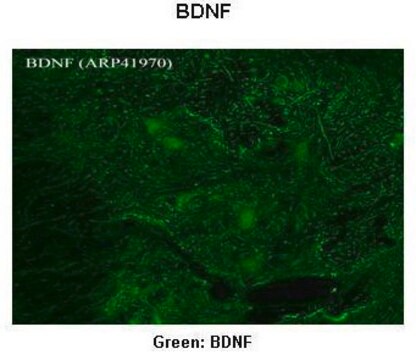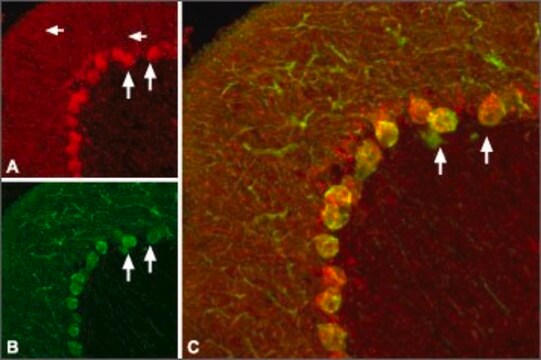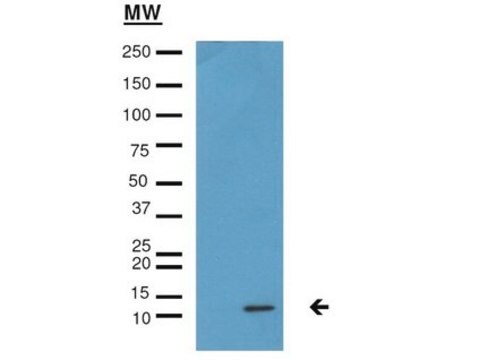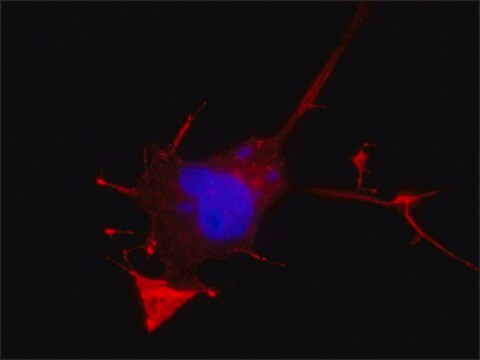05-690
Anticuerpo anti-HP1γ, clon 42s2
clone 42s2, Upstate®, from mouse
Sinónimos:
HP1 gamma, HP1 gamma homolog, Heterochromatin protein 1 homolog gamma, Modifier 2 protein, chromobox homolog 3, chromobox homolog 3 (Drosophila HP1 gamma), chromobox homolog 3 (HP1 gamma homolog, Drosophila), heterochromatin protein HP1 gamma, heterochro
About This Item
Productos recomendados
origen biológico
mouse
Nivel de calidad
forma del anticuerpo
purified antibody
tipo de anticuerpo
primary antibodies
clon
42s2, monoclonal
reactividad de especies
human, mouse
fabricante / nombre comercial
Upstate®
técnicas
ChIP: suitable
immunohistochemistry: suitable
western blot: suitable
isotipo
IgG1
Nº de acceso NCBI
Nº de acceso UniProt
Condiciones de envío
dry ice
modificación del objetivo postraduccional
unmodified
Información sobre el gen
human ... CBX3(11335)
Descripción general
La heterocromatina se caracteriza como cromatina densamente enrollada que suele replicarse tardíamente durante la fase S, tiene una baja densidad de genes y contiene grandes bloques de ADN repetitivo que es relativamente inaccesible a los reactivos modificadores del ADN. En la fase S tardía, la p150 se asocia directamente con las proteínas 1 asociadas a la heterocromatina (HP1α, HP1β y HP1γ). A medida que las células se preparan para la mitosis, la p150 del CAF-1 y algunas HP1 se van disociando progresivamente de la heterocromatina, coincidiendo con la fosforilación de la histona H3. Las proteínas HP1 se vuelven a asociar con la cromatina al final de la mitosis, a medida que se desfosforila la histona H3
Especificidad
Inmunógeno
Aplicación
Epigenética y función nuclear
un laboratorio independiente ha comunicado que este anticuerpo detecta las células HP1γ positivas en el tejido mamario.
Inmunoprecipitación/inmunoprecipitación de la cromatina:
un laboratorio independiente ha comunicado que este anticuerpo provoca inmunoprecipitación de la HP1γ de extractos nucleares y cromatina reticulada en formol.
Biología de la cromatina
Calidad
Análisis mediante inmunoelectrotransferencia (WB):
0,01-0,1 µg/ml de este lote detectó la proteína HP1γ en lisados de células HeLa extraídos con ácido (nº de referencia 13-112).
Descripción de destino
Forma física
Almacenamiento y estabilidad
Nota de análisis
Extractos ácidos HeLa, extractos nucleares HEK 293.
Otras notas
Información legal
Cláusula de descargo de responsabilidad
¿No encuentra el producto adecuado?
Pruebe nuestro Herramienta de selección de productos.
Código de clase de almacenamiento
10 - Combustible liquids
Clase de riesgo para el agua (WGK)
WGK 1
Certificados de análisis (COA)
Busque Certificados de análisis (COA) introduciendo el número de lote del producto. Los números de lote se encuentran en la etiqueta del producto después de las palabras «Lot» o «Batch»
¿Ya tiene este producto?
Encuentre la documentación para los productos que ha comprado recientemente en la Biblioteca de documentos.
Nuestro equipo de científicos tiene experiencia en todas las áreas de investigación: Ciencias de la vida, Ciencia de los materiales, Síntesis química, Cromatografía, Analítica y muchas otras.
Póngase en contacto con el Servicio técnico



